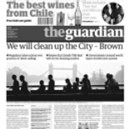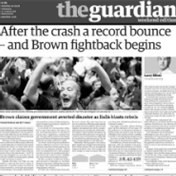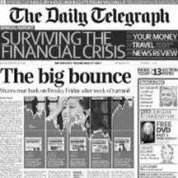Jennie Beck and Jason Vir, Kantar Media
Worldwide Readership Research Symposium Valencia 2009 Session 3.6
Introduction
This is a tale about news consumption. It is based on a series of syndicated studies that have dissected what news is; what it means to consumers; how different platforms contribute to – and extend – the news cycle; and how new means of access are changing the way we perceive the old platforms – particularly newspapers.
We will be summarising findings from the first wave of the study; detailing some of the fascinating findings of the second wave
– a longitudinal qualitative study of the consumption and promulgation of news across an extraordinary week – and whetting the appetite for the third wave, which has a specific focus on the online news business model and takes place just before the 2009 readership symposium. Finally, we’ll be speculating on what impact this new world of news will have on the way we do readership research.
Background
The TNS News Series of projects started with New News in 2006, a qualitative exploration of definitions of news, the structure and cycle of a news story and the consumption of news against a background of growing access to and use of alternative platforms. This gave us a bird’s eye view of the role of each of the new and old platforms in consumers’ lives and in the news cycle. It provided a good general baseline of behaviour and attitudes but we needed more specific feedback, particularly on the relationship between online and print versions of the same newspaper brands.
So, in Tomorrow’s News, in 2008, we decided to take the long view – following the life cycle of a particular news story to dig deeper into the roles of different platforms and brands, and to try and project this forward by looking at three different news user groups – from the youngest ‘digital-only’ groups to the slightly older-mixed media users.
The intention had always been to take a regular foray into news behaviour in order to better advise our clients about the relative positioning of their respective platforms. So, Tomorrow’s News would have been followed by Future News, with a particular focus on whether digital natives were staying with their new platforms or picking up ‘old’ media habits, as their parents had done. But then the world changed – in fact the world changed just as we went into the field with Tomorrow’s News.
But let’s go back to the beginning ….
What is news?
Our first New News qualitative study underlined what has already become apparent from the changing nature of newspaper content – consumers offer a very broad definition of news, and it’s getting broader with time.
“In our parents’ time, half of what we have today would not have reached the papers… Jordan, Posh Spice…”
It’s hard to say whether editors are leading or following this trend, but the increase in acres of newsprint and hours of airtime to fill will inevitably stretch the boundaries of what constitutes news.
What does seem to be clear is that the appetite for news tends to broaden – and increase – with age. Young women have a narrow focus – with celebrity news high up their agenda. Older women add local and national news; travel and weather and comment to the mix, making celebrities take a back seat. For men, interest in sport is a constant but it dominates when they are young and is supplemented by interest in local and national news, comment, business and so forth as they age.
This growth in depth and breadth of interest is a function of changing needs. As this graphic shows, news consumption meets two need-sets, internal and external.
 Figure 1: News needs (New News study 2006)
Figure 1: News needs (New News study 2006)
I E
N X
T T
E E
R R
N N
A A
L L
Simple, practical needs Travel, Weather, TV guides etc.

Broader practical considerations
Health, education, legislation, taxation etc.
Personal interest
Sports results, local news, pet subjects etc.
Social currency Sport, celebrities, big stories Not being the last to know
Contributing / engaging
Professional needs Financial, business, current affairs, specialist etc.
I E
N X
T T
E E
R R
N N
A A
L L
News also has a role in forming an opinion and allowing the user to subscribe to an opinion but the importance of news as social glue, and as an entry ticket to participation in society as a whole, should not be under-estimated. It formed a central theme of our Tomorrow’s News study and is now an important part of the wider discussion about the future of professional and independent journalism.
Personal improvement Increasing knowledge, broadening horizons
Broader engagement Understanding society and my role / place in it
The news cycle
There are, we deduced from our New News study, five stages in the news assimilation process. These can be summarised as:
- Basic awareness. Registering that a story exists and picking up on the type of story and primary subject matter.
This is essentially a passive consumption state – and news can come from any short-form source. It is the start point and, for many, the end-point if there is little interest in the story or time to pursue it. But it can trigger active investigation.
- Passive gathering. Gradually encountering more detail and developing a broader knowledge.
If a story is not of immediate personal importance or general significance, information will be gathered gradually – in an almost subconscious process. It will fed by all available sources, as and when encountered – and informal sources (word of mouth) will play a part here. Stories can then be disregarded or switch to active investigation as more detail is assimilated.
- Active investigation. Seeking out further information, detail and clarification.
Here we move into more direct and conscious engagement with sources most immediately available – including the internet and rolling news on TV. Multiple sources are often used – formal and informal – to build up a picture as quickly as possible but slow-burning stories can spark active investigation too – and that’s where newspapers can play a big role.
- Opinion forming. Establishing a personal perception of the story and owning a relationship to it.
At this stage of the process, consumers will begin to decide where they stand in relation to a story – how does it affect them?, is there an ethical or moral issue involved?, if there are different versions in circulation, which do they believe? In some cases, this will be relatively low-key – little more than filing the story – but in others it can be a very public activity if the story is one that consumers expect to be discussed and debated.
- External engagement. Evaluating other opinions in the light of one’s own views.
As already noted, news forms a key social currency, and this is the stage at which opinion-forming moves from an internal exercise to an external testing of that opinion. This can be in conversation/discussion with others, but testing can be against media views too. Newspapers are an important part of this process (and not just leader columns) but so too are the more analytical TV news and current affairs programmes – and the less formal phone-in shows and chat rooms.
This process is graphically illustrated in Figure 2.
Figure 2: Example of processing news (New News study 2006)
Opinion Forming
External Engagement
Basic Awareness
Pick up headline from breakfast television


Watch the (credible, definitive) late evening news
Update from evening paper
Passive Gathering
Active
See morning paper front page
Passive Gathering
Colleague mentions story
E-mail from a friend
Investigation
Story doesn’t
hang together
News across platforms
So what role does each platform play in this news cycle?
Figure 3 shows the strengths and weaknesses of the key formal platforms – and the informal.
Figure 3: Summary of media roles (New News study 2006)
TV Press
Radio
Internet
Informal
Basic Awareness
✓✓
✓
✓✓
✓
✓
Passive Gathering
✓
?
✓
✓
✓✓
Active Investigation
✓✓
✓
✓✓
?
Opinion Forming
?
✓
?
?
External Engagement
✓
✓✓
✓
✓
Let’s look more closely at the roles of two key platforms:
Newspapers are essentially the critical source of opinion – in the UK at least. The press comes into its own when consumer opinions are formed – and tested against the newspaper’s stance.
But the news role is less clear than it was – on the one hand, newspapers do still break and pursue big stories (we need to look no further than The Telegraph’s MPs’ expenses series for a recent example). But these stories are not time-critical, and much of a daily paper’s content is about providing detail on yesterday’s news – thereby extending the cycle.
What the press can do – better than any other platform – is to offer analysis, comment and an opinion. It’s not just about the story, but about its consequences, implications and impact.
The internet is the ad-hoc active investigative tool now integrated into everyday lives. It’s the dominant news source during the day and is used in a variety of ways – picking up stories via a headline alert or RSS, following a breaking story as it develops or searching archives for depth and background.
It’s still early days in the relationship between the internet and news though, and questions still remain. Will the news assimilation process change as the internet’s impact grows? Are there some stories where newspapers will no longer get a look in? Do values associated with newspaper brands transfer to their online platforms?
It was in order to answer these questions that we embarked on the Tomorrow’s News project.
Introduction to the Tomorrow’s News project
On Friday 12th September 2008 the airline XL collapsed leaving hundreds of passengers stranded around the world. Meanwhile, at 00.00 on the same day, our Incubator website went live and our recruits received invitations to log on and start a news diary that would last over a week. Forty-seven people, aged between 16 and 65 and scattered around the UK, gradually started to join our experiment and began posting greeting messages, pictures of themselves and a record of when and how they accessed the news. By Monday 15th most of them were on board and they woke up to the beginning of the worst financial crisis in modern history – though they didn’t know that yet.
Tomorrow’s News was a ‘virtual ethnography’ exercise. Using an innovative qualitative tool (Incubator) that allowed us to ‘live’ virtually with our respondents, we gathered evidence of the complex nature of news gathering in a syndicated qualitative study conducted in 2008. In our study, cohorts of younger and older news consumers recorded all their contact with news with an online diary, posting links, photos, videos and comments throughout each day. This allowed us as researchers to go on a journey, observing how a news story first sparks interest, to where further information is sourced, both online or offline, to the impact each platform and brand has on conveying facts, forming opinion and encouraging the sharing of opinion with others – thus extending the life of the story and starting the news cycle afresh.
Our study was designed to allow comparisons between ‘digital natives’ who have grown up in the online world and those who grew up pre-internet. The sample comprised three age cohorts: 16-18 year old digital natives who were still in education and bound by family routines; 21-24 year old digital natives who were entering the adult world of work and responsibilities; and 35s and over who grew up with ‘traditional media’, before the widespread use of the internet. All in the sample were future-shaping, avid news consumers, using a range of means of accessing news from different sources, and all were sufficiently technically proficient to take part in the research online.
When we embarked on this study we hoped there would be a large news story that would assist our examination of behaviour across different ages. We were not disappointed. Our research began on Friday the 12th of September 2008, heralding the start of one of the most tumultuous weeks of news in living memory. Our research witnessed the collapse of Lehman Brothers, the fourth largest investment bank in the United States, which sent shock waves around the world and kicked off a rollercoaster week of headlines as the story crossed the Atlantic and left stock markets everywhere holding their breath. Our research immortalised an extraordinary process.
Summary of methodology
We knew we couldn’t just ask people about their news consumption and rely on recall: we wanted to access their episodic processing (knowledge based on specific experiences) as well as their semantic memory (synthesised knowledge about the world in general). We therefore decided on a longitudinal study, combining real-time observation of news consumption with more traditional qualitative interviewing techniques, and adopted a two-stage process of fieldwork, prefaced by a pre-screener:
-
- A self-completion mini-diary exercise in the recruitment process, which we assessed for quality of response more than content, filtering out those who made little effort. We needed reassurance of quality of participation and compliance in our longitudinal and largely remote process.
- A ten-day online diary that we could observe with minimal or very controlled interference. Participants were able to post links, photos, videos and comments throughout the day. While we wanted them to feel part of a community in order to maintain their participation, we were more interested in the individual experience, so we allowed them to see each other’s diary postings and exercises only once they themselves had completed the tasks. A short welcome film by the moderators also helped humanise the online process and set the tone for participation.
- A subsequent face to face discussion, which was used to review the diaries and explore themes thrown up by the news journeys.
The extreme nature of the events offered a fruitful testing ground for our hypotheses. Therefore, once the self-ethnography process of the Incubator was established, over the remaining days we set the participants several exercises, positioned as competitions to encourage creative and thoughtful contributions. What we received back catapulted us into their worlds and magnified the contrasts between their different levels of engagement with the story.
Our three cohorts
As we will see, our three age groups had very different responses to the week’s news events – and their overall attitudes to and access of news were different too.
The 16-18s were casual users of news and they wanted IT to come THEM.
“I use the Metro because it’s free and in my face. I don’t have to go looking for it”
This group tends to gather basic awareness of news stories via the internet – either favoured news, music, celebrity or sports sites or, more likely via MSN or social networking. Their range of news interest is limited and they tend to look for things that have a direct impact on them – teenage crime, music festivals, sport results and so on.
The 21-24s are more opportunistic users of news platforms, they’ll absorb whatever is to hand. News has an important social purpose for this group giving them a means of engaging with their wide circles of friends, family and new work colleagues. They do use a range of print and broadcast platforms but the internet is popular for its speed of accessing relevant content.
“Haven’t watched the news on TV all week cos you have to wait ages to see something you actually like but with the internet you can pick and choose what to take in”
The 35+ group has the widest interest in news and is more routine-driven when it comes to platform choice – morning news on the radio or newspaper; internet at work during the day, TV in the evening. They also actively seek out plurality of source and opinion.
“I like to keep swapping ways I find out the news. I read as many different papers at work as I can get my hands on … to see how the different sides report the news”
A world without news
In order to understand the role that news plays in people’s lives, we asked our participants to imagine a world without news. The postings were surprisingly consistent across the cohorts and the images had a strong emotional impact. Across the board, they spoke of loneliness and vulnerability; many portrayed lost children and the isolation of desert islands; others referred to ignorance and the inability to speak. The commentaries used words such as: isolated, alone, lost, lonely, cut off, insular, empty, deserted, excluded, boring, confused. Some examples follow:


“The picture of the two boys is to show how I would feel left out with no idea what was happening. It would be pretty weird if there was no news, and you would probably never get the correct version of a story from word of mouth unless you heard it from the initial source! The 2nd picture shows how I would feel left out with no idea what was happening elsewhere.” (16-18, Edinburgh)

“I’ve … got a pic of someone with their mouth sewn up. If we didn’t have news most of our conversations and ‘banter’ would not exist, so their would be less for people to say, so people would keep their mouths shut.” (16-18, London)

“The third image is my favourite. The kid is about to get hit by a wave but isn’t aware of it. In many ways I can see a news blackout as having certain positives, such as the blissful ignorance in which we would live without being constantly bombarded with images of how troubling the world is. Obviously this state couldn’t last, but I think that for a while it would be nice to be unaware of anything except things directly effecting my life” (21-24, Edinburgh)

“It would be hard to imagine a world without news because at present it is available in so many things – its there when you wake up, its there to read on the way to work, people interact with it, it creates conversation. It intrigues and causes differences of opinion. If there were no news life would become very insular – topics of conversation would centre around yourself or other people – it would no longer include the world or even regional or local topics of discussion. It would have to rely on word of mouth and you could no longer be sure of what was true. I have likened it to being in a bubble because you would no longer be aware of anything outside of it.” (35+, London)
Clearly our participants felt that news has a very important place in their lives. News provides the individual with information, learning and entertainment. It is about the individual’s interests and concerns; the ‘want to know’ as well as the ‘need to know’. It helps define routines and rituals and creates a sense of self.
But news does far more than this: it creates common general awareness. Being informed means being able to talk about events with other people, to form and share opinions and participate in the ongoing conversation that constitutes the social glue. News is everywhere and is considered an unavoidable part of the day. It fosters the social environment, connecting individuals to one another and the world around them by providing a currency of conversation. It provides a sense of community and belonging. News thus constitutes social space.
Images of desert islands and lonely children serving as metaphors for the absence of news may have positive as well as negative connotations. Some of the images posted also convey a sense of peace and quiet, innocence and blissful ignorance. Many felt the absence of news might also be a relief.

“I lived in Papua New Guinea for three years… I know from personal experience what it is like to know nothing of what is going on… on occasions I felt very isolated but the flip side was I went around in blissful ignorance a lot of the time… Given the current financial gloom and doom issues we are currently facing and are constantly covered in the news sometimes I think it would be really nice to hide away in that forest full of trees.” (35+, Edinburgh)
Observing the three news journeys
While the headlines that week in September were dominated by the financial crisis, the story did not capture everyone’s attention in the same way. In order to make sense of the discrepancies in each cohort, we mapped the main headlines of the day side by side with excerpts from the diaries. This exercise began to reveal cohort-specific patterns, which are reported in this section, alongside some of the headlines in the media as a reminder of the period.
Over the weekend of 13/14th September, the headlines reported on the XL airline collapse and Lehman Brothers in crisis.






…Headlines continue to report airline crises …Lehman Brothers in crisis…
But mostly weekend routines•
OPINION
FORMING
on the XL story
Low-level BASIС
AWARENESS
Of Lehman’s
The weekend of 13/14 September
16-18 year olds revealed no awareness of the Lehman Brothers news and just a basic knowledge of the XL story. They were interested mostly in sports, entertainment and light-hearted stories.
The 21-24 year olds recorded some awareness of the collapse of XL, which had personal impact for some, but their attention, too, was mostly on sport and entertainment, as well as human interest and celebrity stories.
The 35s and over showed a low level awareness of the Lehman Brothers story and were forming opinions on the XL story, alongside their weekend routines.
By Monday 15th September, the headlines were reporting Lehman Brothers declaring bankruptcy and stock markets around the world crashing. A few of the 16-18 year olds began to be conscious of Lehman Brothers in crisis – from radio and Metro newspaper headlines in the morning on the way to college – but by the end of the day they still showed little awareness of the financial crisis.






…Lehmann Brothers declares bankruptcy…Stock markets crash around the world
ALMOST ALL
aware by end of day
SWITСHED ON from first thing – many use RADIO
TIMING means INTERNET comes into its own for further updates during the day
Monday 15th Sept
In contrast, there was by now awareness of the crisis among 21-24 year olds, but this was mixed with consumption of local news and interest in some gruesome stories. (A vile gang of devil worshippers has killed and eaten four Russian teenagers in a sickening ritual). The 35s and over displayed much more acute awareness and interest in the unfolding financial crisis. They clocked on to it from first thing
- mostly by radio – and by the end of the day almost all were aware of the story. Most found the news gripping, and the internet came into its own for further updates throughout the day.
Wednesday 17th September saw the financial crisis swing dramatically across the Atlantic, with headlines reporting shares in HBOS crashing amid fears for UK banking jobs and a bail out in the US for AIG. The few 16-18 year olds who were by now following the financial crisis started to show signs of fatigue, but there was still no active investigation by most.
| Wednesday 17th Sept
Lots of AСTIVE INVESTIGATION Evidence of СHANGING BEHAVIOUR |
| …HBOS Shares crash… Fears for UK Banking jobs… AIG Bailed Out… |
The takeover of HBOS by Lloyds TSB brought the crisis firmly on to centre stage for the 21-24s. It was no longer a story about American banks, but about British job losses, and some were worried about unemployment figures.
The 35s and over continued to reveal lots of active investigation and more evidence of increasing news consumption due to the extraordinary news. (“I caught the news on Radio 4 but I intend to get a paper to read more about Lehman. I may well understand it better that way.”)
On Tuesday 16th September, headlines reported on the world reacting to the Lehman Brothers collapse, fears for AIG, and central banks pumping funds into the markets. Despite this domination of the headlines, few of the 16-18 year olds revealed any sense of connection with the financial crisis, considering it either too confusing or simply irrelevant. They remained hooked on human interest news stories. (“During school I talked for a bit with friends about the news that Damien Hirst sold £111 million worth of his art. It’s a much lighter topic as opposed to discussing the depressing economy stories.”)
Though displaying more interest, there was a general sense among the 21-24 year olds that the crisis did not affect them very much as yet. However, among the 35s and over, the financial crisis was by now considered the main news with its domination of the headlines. There were some, though, who sought out a brighter side in their news.







…World reacts… Fears for AIG… Central Banks pump funds into markets…
Seen to be
DOMINATING
the news• as the headlines atest
Early signs of
FATIGUE?
Nowseen as the
MAIN NEWS
Tuesday 16th Sept








The headlines on Thursday 18th September reported Lloyds TSB announcing the takeover of HBOS, billions wiped off markets and governments intervening. News of the financial crisis was everywhere – but still mostly ignored or mentioned only in passing by our 16-18 year olds. Instead, celebrity news and human stories with an element of drama continued to capture their interest.









… Billions wiped off markets… Governments intervene…
SATURATION POINT
The story is EVERYWHERE
..they wish it wasn’t!
Thursday 18th Sept
The 21-24 year olds displayed their first signs of crisis fatigue, with some citing scepticism about the role of the media in hyping the story. They wanted to move on to different news. (“Today I felt that after having spent so much of my news reading time on following the financial crisis and updates relating to this that I have perhaps neglected other areas of news.”)
The 35s and over appeared to have reached saturation point with the financial crisis story: it was everywhere and they wished it were not!
Friday 19th September’s headlines reported Thursday’s intervention taking effect, with markets rallying and stocks booming to finish the week. Among the 16-18 year olds there was no mention of the crisis at all, even by the few who had touched on it previously. Most were gearing up for the weekend and were tired of any ‘serious’ news.







…Thursday’s intervention takes effect…Markets rally and stocks boom …
Сlear DROP in comments about economy
PRESS
OVERKILL?
RETURN TO
WEEKEND
MENTALITY?
Friday 19th Sept
The 21-24s showed some relief as the markets picked up, but they had a sense that there was more to come.
There was a clear drop in comments about the economy among the 35s and over. (“10.00am Just before a meeting – discuss the news and the effect which the financial situation will have on our area of work and all the sport coming up at the weekend.”) Was this press overkill? Were they slipping into their weekend mindset?
The headlines over the weekend of 20th and 21st September suggested the worst of the crisis was finally over. The 16-18 year olds resumed their weekend routines as if the financial crisis had never happened. Most reported catching up on sports, celebrity news and gossip, with increased newspaper consumption as opposed to use of other platforms.






…They think it’s all over…
Back into the weekend routine – sports, etc.
Most are relieved that the worst appears to be over
Some in-depth newspaper reading – from a more comfortable distance?
The weekend of 20th/21st Sept
News consumption slowed down for the 21-24 year olds. The Islamabad Marriott bombing and other international news caught their attention amid relief that strong banks had stepped in to rescue the failing. The 35s and over also got back into their weekend routine. Most were relieved that the worst appeared to be over. Some reported in-depth newspaper reading – taking in the news from a more comfortable distance.
Of course, the story was far from over.
The narrative cycle
The three journeys also told us something about the cyclical nature of news as narrative.
People picked up the story at different rates, depending on their age and their involvement and responsibilities, but most showed a short tolerance for the unfolding news. Earlier on it seemed too technical or too far removed – something that was happening across the Atlantic – and people quickly turned to sport or local news. When the magnitude and relevance of the events sank in, people became involved and engaged but after a while they began to show signs of crisis fatigue and to adopt a number of escape measures, ranging from cynicism (“It’s all a hype engineered by the media”) to eager optimism (“It’ll all be over by the end of the week”).
It emerged quite clearly that people expect every story to have a lifecycle, with a cliffhanger and, eventually, a resolution. This structure is reinforced by both newspaper headlines and the working week. Initially people are captivated by breaking news, their interest is maintained over a period of time, until they are satiated and then they want closure. This is why news stories engage, but also why fatigue sets in. The pattern of the working week means that news appears to happen between Monday and Friday and it stops at the weekend (or at least is expected to). The weekend is either an excuse to switch-off news altogether, or to relax into a different kind and tempo of news.
Newspapers and the internet
Given their respective roles in news assimilation in normal times, how did press and the internet cope in a crisis?
The internet became more of a source of breaking news than usual, especially given the global nature of the story, with much happening overnight. Some consumers found themselves searching for updates from additional sources (following links to specialist sources new to them, for example) – before arriving back at the same trusted sources (newspapers or TV online brands).
For newspapers we found that consumers tended to revert to traditional, trusted newspapers – but not exclusively ‘their paper.’ There was a tendency to switch or add titles to get a range of opinions – and to follow-up snippets spotted online or in free papers.
Essentially newspapers seemed to have three distinct roles:
-
- Making the story – this included keeping us in the loop, using stark/shock headlines to influence the mood and convey the gravity of the situation (or fan the flames, depending on your point of view)
- Making it relevant – national and local papers went beyond the headlines to make the story more real, interviewing those affected, giving it a local or human face, and keeping interest levels high
- Lifting the mood – by the end of the week newspapers were resolving/closing the story but also beginning to play to weekend needs, recognising story fatigue and the need to relax
In fact, weekend papers seemed to become more important – partly to add depth to the story, but also to escape it, in the more relaxing environment of leisure, sport, travel and arts sections that fill the weekend package.
Even outside a crisis period, the relationship between newspapers and the internet changes at the weekend and newspapers become a much more important part of the news-gathering (or news avoidance) agenda. This is even true for the 16-18s who avoid newspapers during the week.
“There are a few news consumption changes I make on Sundays. First of all, I usually read a newspaper and its supplements on a Sunday as I’m usually round the house and it’s more relaxing. I don’t watch a lot of television on Sundays so that limits the amount of televised news I can watch, I think there might be less news on Sundays anyway. Also, I don’t use websites as much.”
Print and online brands
The final entry in our Tomorrow’s News journal concerns the strength of news brands – and, in particular, the transfer of brand values from newspaper to online platform.
People value the ability to keep informed, to know what is going on with a certain degree of confidence. We asked, if there were no (official) news, who could they listen to? The responses showed that brand allegiance can survive the proliferation of sources – people still trust certain sources and specifically certain brands.
This was underlined by our probing of the credibility of word of mouth, which was met with cautionary questions. Is it reliable? Is it accurate? Can it be trusted? What are the messenger’s credentials?
Clearly, trustworthiness remains important. There is a desire for facts and the understanding is that “the truth” is out there, and some sources are better than others at reporting it. It is delivered by familiar news brands, based on a relationship of trust. Even online, traditional news brands kick in when news moves beyond light-hearted, entertainment value.
However, the difference in use and assimilation patterns between the print and online versions of the same brand leads to some interesting differences in perceptions of brand equity.
With the newspaper version of the brand, there is a tangible and comprehensive package – and the whole (or sum of the parts) is a big driver of the attachment that the user feels to the brand and the values associated with it. Online, the brand is consumed only a bit at at time, so the brand reputation is a little less sticky online (unless you use the online version in the same way you do the print version).
The competitive environment also plays a part. In the newspaper world, we choose our brands from a small range of options, most of which we have a fairly firm view of. Online we are faced with a huge range of alternatives and one that seems to change by the day (that’s part of the attraction). So the newspaper brand has to fight for attention. If it’s presented as an option, it will be high up the preference list because it’s a known entity but it is not the automatic first choice – however strong the offline commitment.
What has happened since Tomorrow’s News?
We weren’t just researching the credit crunch news story in Tomorrow’s News, the story itself has exposed and accelerated the challenges facing our newspaper clients. So the big question that started this news series going has started to shift from “how does a news provider deliver well across multiple platforms?” to “how do we secure the future of journalism?”.
A further qualitative study will be conducted in September 2009, looking at the new debate about funding journalism through alternative online or offline revenue sources – but in a ‘taster’ session run in July, we found little general awareness of the current plight of national or local newspapers. That’s partly because our news cosumers can’t really believe that papers are in trouble – there’s no observable change to what they’re delivering – thereby increasing the challenge for cash-strapped publsihers.
What has this to do with readership research?
Given the changing nature of newspaper consumption and the move to online access, we can speculate about the ways in which ‘readership’ may need to develop in the future, and the new newspaper world that it will need to take into account.
-
- Recognition of the difference between a newspaper reading occasion and an online reading occasion – so a requirement for a more qualitative measure of online reading?
- Reduced regularity of reading during the week/increased sporadic reading may require new frequency definitions – and may not clear current recall hurdles
- Increasing emphasis on weekend reading – for readers and advertisers. Will we need more depth/more detail about sections, supplements, reading intensity on the weekend?
- The main news section may no longer be the main point of entry for readers. Additional sections more important/main news more peripheral.
- If online access is dominant during the week and print access at the weekend, should we be adpating our data collection methodologies accordingly?